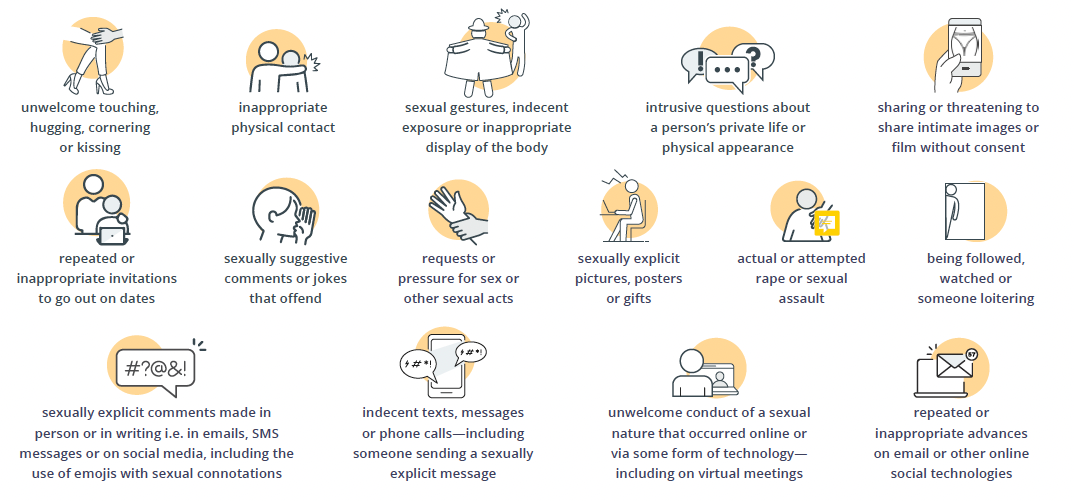Defining workplace sexual harassment
How do you define and recognise workplace sexual harassment?

The first thing to understand about workplace sexual harassment is that it is common and widespread. It occurs in every industry, in every location and at every level within organisations across the country. 1 in every 3 people have experienced sexual harassment at work in the last five years.
While sexual harassment has been occurring in Australian workplaces for a long time, it has gained significant media attention in recent years, particularly in light of the #MeToo campaign and a number of high-profile sexual harassment cases emerging in the media. It is important to remember that behind all the stories you see in the media are real people, and real workplaces.
For every headline that you read there are many more stories that are not being told. The impacts of workplace sexual harassment are profound and devastating for both individuals and workplaces. Crucially, workplace sexual harassment, and its impacts, are preventable. You can take actions to prevent workplace sexual harassment. First though, what is workplace sexual harassment?
Australian law states that sexual harassment occurs when:
a person makes an unwelcome sexual advance, or an unwelcome request for sexual favours, to the person harassed; or engages in other unwelcome conduct of a sexual nature in relation to the person harassed;
in circumstances in which a reasonable person, having regard to all the circumstances, would have anticipated the possibility that the person harassed would be offended, humiliated or intimidated.
In determining whether an advance, request or other conduct may be sexual in nature, the intention of the alleged harasser is not relevant. An advance, request or other conduct may be sexual in nature even if the person engaging in the conduct does not have a sexual interest in that person or is of a different sexual orientation to the person harassed.
Examples of sexual harassment:

These examples of workplace sexual harassment include:
- inappropriate physical contact
- intrusive questions about a person’s private life or physical appearance
- sharing or threatening to share intimate images or film without consent
- unwelcome touching, hugging, cornering or kissing
- repeated or inappropriate invitations to go out on dates
- sexually suggestive comments or jokes that offend or intimidate
- requests or pressure for sex or other sexual acts
- sexually explicit pictures, posters or gifts
- actual or attempted rape or sexual assault
- being followed, watched or someone loitering
- sexually explicit comments made in person or in writing, or indecent messages (SMS, social media), phone calls or emails—including the use of emojis with sexual connotations
- sexual gestures, indecent exposure or inappropriate display of the body
- unwelcome conduct of a sexual nature that occurs online or via some form of technology—including on virtual meetings
- inappropriate staring or leering
- repeated or inappropriate advances on email or other online social technologies
Unwelcome conduct is behaviour which has not been invited or solicited by a person, and which the recipient regards as undesirable, offensive or disagreeable. Whether the behaviour is unwelcome is a subjective question from the perspective of the person alleging sexual harassment. The behaviour may still be unwelcome even where it:
- may not have been unwelcome to others
- has been accepted behaviour in the work environment in the past
- was not intended to be sexual or to offend, humiliate or intimidate
Conduct can become unwelcome at any time.
It is not necessary for the person harassed to have explicitly addressed the behaviour or informed their alleged harasser that the behaviour is unwelcome.
The final element of the legal definition of sexual harassment considers whether the behaviour occurred in circumstances in which a reasonable person would anticipate the possibility that such conduct would offend, humiliate, or intimidate the person harassed.
This is an objective test: would a reasonable person, having regard to all the circumstances, have anticipated the possibility that the harassed person would be offended, humiliated or intimidated by the behaviour? The list of circumstances a court considers to determine this includes:
- the sex, age, sexual orientation, gender identity, intersex status, marital or relationship status, religious belief, race, colour, national or ethnic origin
- the relationship between the parties involved
- any disability of the person harassed.
Legal framework
There are a number of laws in Australia, at both the federal and state/territory levels, that are relevant to workplace sexual harassment. These laws seek to create safer and more respectful workplaces:
Prohibits sex discrimination, sexual harassment, sex-based harassment and victimisation in the workplace and a number of other areas of ‘public life’.
Provides remedies to people who may have experienced sexual harassment at work and confirms that sexual harassment can be a valid reason for dismissal and can be considered serious misconduct. Provides the Fair Work Commission with the ability to issue an order to stop sexual harassment at work.
In addition to the federal legislation, each state and territory in Australia has anti-discrimination legislation which prohibits sex discrimination, sexual harassment and victimisation. Commonwealth laws and the state/territory laws generally overlap to a certain degree. However, the laws apply in different ways and there are differing thresholds for sexual harassment.
Commonwealth, state and territory work health and safety (WHS) laws require persons conducting a business or undertaking (PCBU), such as employers, to ensure the safety of workers and others at work. Sexual harassment is a physical and psychosocial hazard that creates risks to physical and psychological health and safety. PCBUs must eliminate or minimise the risk of sexual harassment at work so far as reasonably practicable.
Commonwealth, state and territory workers’ compensation laws establish a no-fault scheme for the compensation and workplace rehabilitation of employees who have had work-related injuries. Workers’ compensation laws require employers to take out insurance to fund potential liability for workers injured at work, including injury/illness which arises from workplace sexual harassment. The insurance premiums vary between jurisdictions.
Certain types of sex discrimination, sexual harassment and sex-based harassment may also be an offence under criminal law. For example, sexual assault, indecent assault, indecent exposure, stalking, obscene communications, recklessly or seriously causing injury.
Sexual harassment and sex-based harassment
Sex-based harassment is also unlawful. Though they sound similar, and often occur in combination, sexual harassment and sex-based harassment are different. As we have just discussed in detail, sexual harassment is unwelcome conduct of a sexual nature that may offend, humiliate, or intimidate. Sex-based harassment is defined as unwelcome conduct of a seriously demeaning nature by reason of the person’s sex in circumstances in which a reasonable person that may offended, humiliate or intimidate.
Some examples of sex-based harassment could include:
- Asking intrusive personal questions based on a person's sex.
- Making inappropriate comments and jokes to a person based on their sex.
- Displaying images or materials that are sexist, misogynistic or misandrist.
- Making sexist, misogynistic or misandrist remarks about a specific person.
- Requesting a person to engage in degrading conduct based on their sex.
Online harassment
Laws that prohibit workplace sexual harassment also apply to online communications which occur in the virtual workspace. Workplace sexual harassment perpetrated using work devices and/or personal devices such as phones, computers, tablets is against the law. Also, the sexual harassment of workers through social media, even if using private equipment or during non-work hours, can still be against the law.

